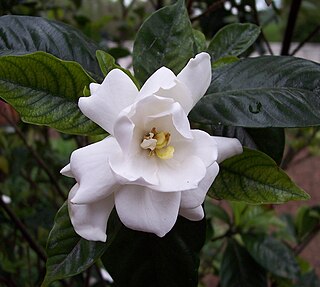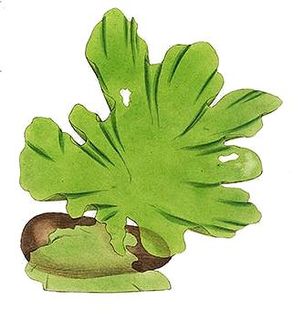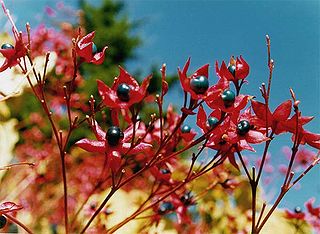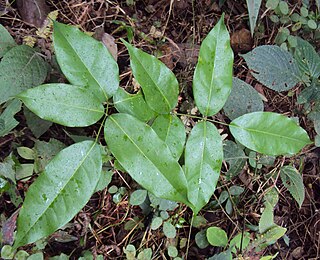
Gardenia is a genus of flowering plants in the coffee family, Rubiaceae, native to the tropical and subtropical regions of Africa, Asia, Madagascar and Pacific Islands, and Australia.

The sea lettuces comprise the genus Ulva, a group of edible green algae that is widely distributed along the coasts of the world's oceans. The type species within the genus Ulva is Ulva lactuca, lactuca being Latin for "lettuce". The genus also includes the species previously classified under the genus Enteromorpha, the former members of which are known under the common name green nori.

Hyphessobrycon is a genus of freshwater fish in the family Characidae. These species are among the fishes known as tetras. The genus is distributed in the Neotropical realm from southern Mexico to Río de la Plata in Argentina. Many of these species are native to South America; about six species are from Central America and a single species, H. compressus is from southern Mexico.

Johan Barthold Jongkind was a Dutch painter and printmaker. He painted marine landscapes in a free manner and is regarded as a forerunner of Impressionism.
The Thermotogae are a phylum of the domain Bacteria. The phylum Thermotogae is composed of Gram-negative staining, anaerobic, and mostly thermophilic and hyperthermophilic bacteria.

Cardinalfishes are a family, Apogonidae, of ray-finned fishes found in the Atlantic, Indian, and Pacific Oceans; they are chiefly marine, but some species are found in brackish water and a few are found in fresh water. A handful of species are kept in the aquarium and are popular as small, peaceful, and colourful fish. The family includes about 370 species.

Szechuanosaurus is an extinct genus of carnivorous theropod dinosaur from the Late Jurassic. Fossils referred to the genus have been found in China, Asia in the Oxfordian-?Tithonian. Its type species is largely based on several undiagnostic teeth from the Shangshaximiao Formation and it is possibly also known from the Kuangyuan Series and the Kalaza Formation, both also located in China.

Cottus is a genus of the sculpin family Cottidae. They are often referred to as the "freshwater sculpins", as they are the principal genus of sculpins to be found in fresh water. They are native to the Palearctic and Nearctic.

Sangeet Natak Akademi Puraskar is an award given by the Sangeet Natak Akademi, India's National Academy of Music, Dance & Drama. It is the highest Indian recognition given to practicing artists. The award earlier in 2003, consisted of Rs. 50,000, a citation, an angavastram, and a tamrapatra. Since 2009 cash prize has been increased to ₹1,00,000. The awards are given in the categories of music, dance, theatre, other traditional arts and puppetry, and for contribution/scholarship in performing arts.

Clerodendrum is a genus of flowering plants formerly placed in the family Verbenaceae, but now considered to belong to the Lamiaceae (mint) family. Its common names include glorybower, bagflower and bleeding-heart. It is currently classified in the subfamily Ajugoideae, being one of several genera transferred from Verbenaceae to Lamiaceae in the 1990s, based on phylogenetic analysis of morphological and molecular data.
Sinocyclocheilus is a genus of freshwater fish in the family Cyprinidae endemic to China, where only found in Guangxi, Guizhou and Yunnan. Almost all of its species live in or around caves and most of these have adaptions typical of cavefish such as a lack of scales, lack of pigmentation and reduced eyes. Several species have an unusual hunchbacked appearance and some of the cave-dwellers have a "horn" on the back, the function of which is unclear. In contrast, the Sinocyclocheilus species that live aboveground, as well as a few found underground, show no clear cavefish adaptions. They are relatively small fish reaching up to 23 cm (9.1 in) in length. The individual species have small ranges and populations, leading to the status of most of the evaluated species as threatened. Many species populations in the genus have yet to be evaluated by the IUCN.

Schistura is a genus of fish in the stone loach family Nemacheilidae native to the streams and rivers of the southern and eastern Asia. Some of these species are troglobitic.

The Synergistetes is a recently recognized phylum of anaerobic bacteria that show Gram-negative staining and have rod/vibrioid cell shape.
Nitrospirae is a phylum of bacteria. It contains only one class, Nitrospira, which itself contains one order (Nitrospirales) and one family (Nitrospiraceae). It includes multiple genera, such as Nitrospira, the largest. The first member of this phylum, Nitrospira marina, was discovered in 1985. The second member, Nitrospira moscoviensis, was discovered in 1995.

Hyperodapedontinae is a subfamily of rhynchosaurs within the family Hyperodapedontidae. Fossils have been found from Argentina, Brasil, Canada, India, Madagascar, Scotland, Tanzania, United States and Zimbabwe.
The species Sudan ebolavirus is a virological taxon included in the genus Ebolavirus, family Filoviridae, order Mononegavirales. The species has a single virus member, Sudan virus (SUDV). The members of the species are called Sudan ebolaviruses.

Dendrobieae is a tribe in the subfamily Epidendroideae, in the family Orchidaceae.
Penicillium citrinum is an anamorph, mesophilic fungus species of the genus of Penicillium which produces tanzawaic acid A-D, ACC, Mevastatin, Quinocitrinine A, Quinocitrinine B, and nephrotoxic citrinin. Penicillium citrinum is often found on moldy citrus fruits and occasionally it occurs in tropical spices and cereals. This Penicillium species also causes mortality for the mosquito Culex quinquefasciatus. Because of its mesophilic character, Penicillium citrinum occurs worldwide. The first statin (Mevastatin) was 1970 isolated from this species.

Rourea is a genus of plants in the family Connaraceae. They are found worldwide across the tropics and subtropics.













